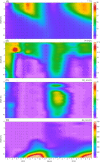Succession of bacteria and archaea involved in the nitrogen cycle of a seasonally stratified lake
- PMID: 36796795
- PMCID: PMC9990978
- DOI: 10.1093/femsle/fnad013
Succession of bacteria and archaea involved in the nitrogen cycle of a seasonally stratified lake
Abstract
Human-driven changes affect nutrient inputs, oxygen solubility, and the hydrodynamics of lakes, which affect biogeochemical cycles mediated by microbial communities. However, information on the succession of microbes involved in nitrogen cycling in seasonally stratified lakes is still incomplete. Here, we investigated the succession of nitrogen-transforming microorganisms in Lake Vechten over a period of 19 months, combining 16S rRNA gene amplicon sequencing and quantification of functional genes. Ammonia-oxidizing archaea (AOA) and bacteria (AOB) and anammox bacteria were abundant in the sediment during winter, accompanied by nitrate in the water column. Nitrogen-fixing bacteria and denitrifying bacteria emerged in the water column in spring when nitrate was gradually depleted. Denitrifying bacteria containing nirS genes were exclusively present in the anoxic hypolimnion. During summer stratification, abundances of AOA, AOB, and anammox bacteria decreased sharply in the sediment, and ammonium accumulated in hypolimnion. After lake mixing during fall turnover, abundances of AOA, AOB, and anammox bacteria increased and ammonium was oxidized to nitrate. Hence, nitrogen-transforming microorganisms in Lake Vechten displayed a pronounced seasonal succession, which was strongly determined by the seasonal stratification pattern. These results imply that changes in stratification and vertical mixing induced by global warming are likely to alter the nitrogen cycle of seasonally stratified lakes.
Keywords: ammonia-oxidizing archaea; ammonia-oxidizing bacteria; anaerobic ammonium oxidation; denitrification; nitrogen fixation; stratified lake.
© The Author(s) 2023. Published by Oxford University Press on behalf of FEMS.
Figures






Similar articles
-
Ammonia-oxidizing archaea and bacteria in water columns and sediments of a highly eutrophic plateau freshwater lake.Environ Sci Pollut Res Int. 2016 Aug;23(15):15358-69. doi: 10.1007/s11356-016-6707-0. Epub 2016 Apr 25. Environ Sci Pollut Res Int. 2016. PMID: 27109114
-
Diversity and abundance of comammox bacteria in the sediments of an urban lake.J Appl Microbiol. 2020 Jun;128(6):1647-1657. doi: 10.1111/jam.14593. Epub 2020 Feb 14. J Appl Microbiol. 2020. PMID: 31989773
-
Microbial community of nitrogen cycle-related genes in aquatic plant rhizospheres of Lake Liangzi in winter.J Basic Microbiol. 2018 Nov;58(11):998-1006. doi: 10.1002/jobm.201800220. Epub 2018 Aug 17. J Basic Microbiol. 2018. PMID: 30117537
-
Responses of Active Ammonia Oxidizers and Nitrification Activity in Eutrophic Lake Sediments to Nitrogen and Temperature.Appl Environ Microbiol. 2019 Aug 29;85(18):e00258-19. doi: 10.1128/AEM.00258-19. Print 2019 Sep 15. Appl Environ Microbiol. 2019. PMID: 31253684 Free PMC article.
-
Thermophilic microorganisms involved in the nitrogen cycle in thermal environments: Advances and prospects.Sci Total Environ. 2023 Oct 20;896:165259. doi: 10.1016/j.scitotenv.2023.165259. Epub 2023 Jul 2. Sci Total Environ. 2023. PMID: 37400035 Review.
Cited by
-
Seasonal Variability of Cultivable Nitrate-Reducing and Denitrifying Bacteria and Functional Gene Copy Number in Fresh Water Lake.Microorganisms. 2024 Mar 2;12(3):511. doi: 10.3390/microorganisms12030511. Microorganisms. 2024. PMID: 38543561 Free PMC article.
References
-
- Beauchamp RO, Bus JS, Popp JAet al. . A critical review of the literature on hydrogen sulfide toxicity. CRC Crit Rev Toxicol. 1984;13:25–97. - PubMed
-
- Biderre-Petit C, Taib N, Gardon Het al. . New insights into the pelagic microorganisms involved in the methane cycle in the meromictic Lake Pavin through metagenomics. FEMS Microbiol Ecol. 2019;95:fiy183. - PubMed

